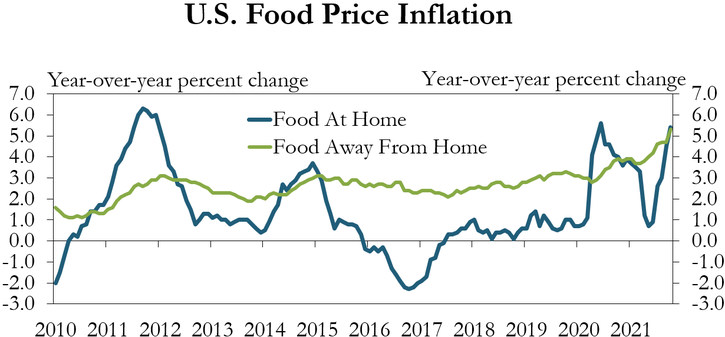If it seems like grocery prices have been higher lately, you’re not alone. And, this year’s Thanksgiving meal could also be affected.
What is behind the rise in food prices?
Nathan Kauffman, vice president, economist and Omaha Branch executive for the Federal Reserve Bank of Kansas City, says several factors are causing higher food costs. “The bottlenecks in supply chains are one contributor, shopping habits have also changed since the pandemic, and increased transportation costs are all feeding into higher food prices,” he said.
Kauffman points to challenges in the meat supply chain as an example.
“We’re currently seeing disruptions in several areas of the meat supply chain between when an animal leaves the farm and when food reaches the consumer,” he said. “Meat processors are having a hard time finding labor and the shortage of truck drivers are just two examples.” The potential silver lining for Thanksgiving, Kauffman adds, is that the prices of turkeys haven’t climbed as much as beef.
How much more should you expect to dish out for this year’s Thanksgiving meal?
According to one estimate from the American Farm Bureau Federation, your turkey day spread could cost 4 to 5 percent more than last year. $46.90 was the average cost for a Thanksgiving meal calculated by the Farm Bureau in 2020. The good news is that while prices have risen, meat production has remained steady in 2021, according to the Kansas City Fed’s PDFthird quarter Ag Bulletin.
“As of right now, availability doesn’t seem as much of a problem as last year. We haven’t been seeing food supply shortages like we did at the beginning of the pandemic,” Kauffman said.
What role is inflation playing in food prices?
If you compare food prices over several decades as a percentage of a household’s weekly earnings, it’s true that today’s grocery runs are costing less. However, the actual prices we’re paying for food have increased and at a faster rate than we’re typically used to. The U.S. Department of Agriculture reports that the 20-year annual average for food price increases rests at 2 percent. However, their calculations show the nation saw a 4.6 percent increase from September 2020 to September 2021.
Chart 1

Note: Food at home refers to the total expenditures for food at grocery stores (or other food stores) and food prepared by the consumer unit on trips. It excludes the purchase of nonfood items. Food away from home includes all meals (breakfast and brunch, lunch, dinner and snacks and nonalcoholic beverages) including tips at fast food, take-out, delivery, concession stands, buffet and cafeteria, at full-service restaurants, and at vending machines and mobile vendors. Also included are board (including at school), meals as pay, special catered affairs, such as weddings, bar mitzvahs, and confirmations, school lunches, and meals away from home on trips.
Sources: Bureau of Labor Statistics and Haver Analytics.
Those with tighter budgets are likely to notice it the most. “Since last year, food prices are quite a bit higher, and they rose more quickly than we are used to,” Kauffman explained. “When prices increase at a swift pace like they are now, lower-income households tend to be affected the most. It’s unfortunate because the pandemic has already had the greatest impact on them.”
More resources
Interested in reading more about agriculture, supply chains and their effects on the economy? Here are some more resources for you:
External LinkLatest updates on Agriculture and the Economy
